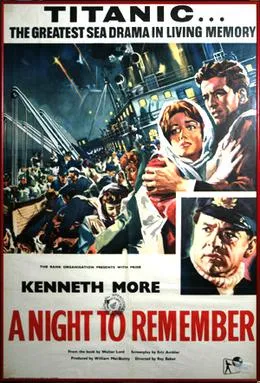Historical accuracy of A Night to Remember

Historical accuracy of A Night to Remember

Characters
Charles Lightoller
Generally portrayed accurately as the senior surviving officer focused on duty, though perhaps slightly idealized as the central heroic figure.
Captain Edward Smith
Depicted as competent but flawed, making crucial errors, which aligns with historical views but avoids making him seem totally incompetent.
Thomas Andrews
Portrayed poignantly as the designer aware of the ship's fate, consistent with historical accounts of his actions during the sinking.
J. Bruce Ismay
Portrayed (sometimes unnamed) escaping the ship, reflecting the controversy surrounding him, though his motives and actions remain debated.
Margaret "Molly" Brown
Shown accurately taking charge in the lifeboat, reflecting her known actions and personality during the disaster.
William Murdoch
Shown taking action during the collision and loading boats, but some actions (like launching Boat 1 underfilled) are simplified portrayals.
More characters
Harold Bride
Accurately depicted as one of the radio operators staying at his post sending distress signals.
Charles Joughin
Portrayed as the baker who survived partly due to alcohol, aligning with his famous survival story.
Benjamin Guggenheim
Accurately shown dressing in his best to die like a gentleman.
Mr. & Mrs. Lucas
Composite characters created to represent the experiences of families, particularly in second class, streamlining the narrative.
Mr. & Mrs. Clarke
Composite characters likely based on real honeymooning couples aboard, used for narrative effect.
Arthur Rostron
Portrayed briefly but accurately as the determined captain racing to the rescue scene.
Story
Titanic strikes an iceberg
The central event initiating the disaster is accurately depicted as the cause of the sinking.
Ship believed "unsinkable"
The film reflects the contemporary hubris and belief in the ship's invincibility due to its design.
Insufficient lifeboats for all
The film accurately portrays the inadequate number of lifeboats as a major factor in the high death toll, meeting outdated regulations.
Iceberg warnings received but ignored
The film depicts multiple warnings being received but not given sufficient attention by the bridge officers.
Sinking occurred early April 15, 1912
The timeline of the collision (late April 14) and sinking (early April 15) is historically correct.
SS Californian nearby, saw rockets
Portrays the controversial incident where the Californian was nearby, saw rockets, but failed to render aid, reflecting inquiries' findings.
Carpathia races to rescue survivors
The rescue efforts by the Carpathia are accurately shown as the means by which survivors were saved.
Ship sinks intact (doesn't break)
Depicts the ship sinking in one piece, which was a common belief based on conflicting accounts before the wreck was found in 1985 confirming it broke apart.
Class distinctions impacted survival
The film subtly shows how class barriers and deck locations influenced passengers' access to lifeboats.
Some lifeboats launched under-filled
Accurately depicts early lifeboats being launched without their full capacity due to confusion and crew uncertainty.
Ship's band played during sinking
Represents the famous accounts of the musicians playing on deck to calm passengers as the ship sank.
Officers issued firearms
The scene where officers receive revolvers to maintain order during the boat loading is based on historical accounts.
Depicts Titanic being christened
The opening montage shows a christening ceremony, but White Star Line did not traditionally christen their ships, including Titanic.
Lightoller strictly enforcing "women/children"
Lightoller's strict interpretation of the "women and children first" order on the port side is accurately shown.
Setting
Sets based on Titanic blueprints
Significant effort was made to recreate the ship's interiors and exteriors accurately using original plans, enhancing authenticity.
Edwardian costumes and attire
The costumes effectively capture the fashion of 1912, adding to the film's period atmosphere, especially for first-class passengers.
Accurate White Star Line uniforms
Officer uniforms, like Lightoller's, are shown with correct details such as rank insignia and style, reflecting regulations of the era.
Depiction of social atmosphere
The film captures the social stratification and general Edwardian "stiff upper lip" behavior described by survivors and historians.
Visual effects of the sinking
Limited by the technology of 1958, the sinking effects are impressive for their time but less realistic than modern capabilities.
Use of (some anachronistic) newsreels
The film uses newsreel footage for context, but some clips (like the supposed launch) are from later periods (e.g., 1930s).
Representation of ship's scale/luxury
While sets were detailed, the overall sense of the ship's immense scale and opulence is perhaps less emphasized than in later, bigger-budget films.
Depiction of the freezing Atlantic cold
While the danger is clear, the extreme, lethal nature of the cold water is perhaps underplayed compared to modern knowledge of hypothermia.
